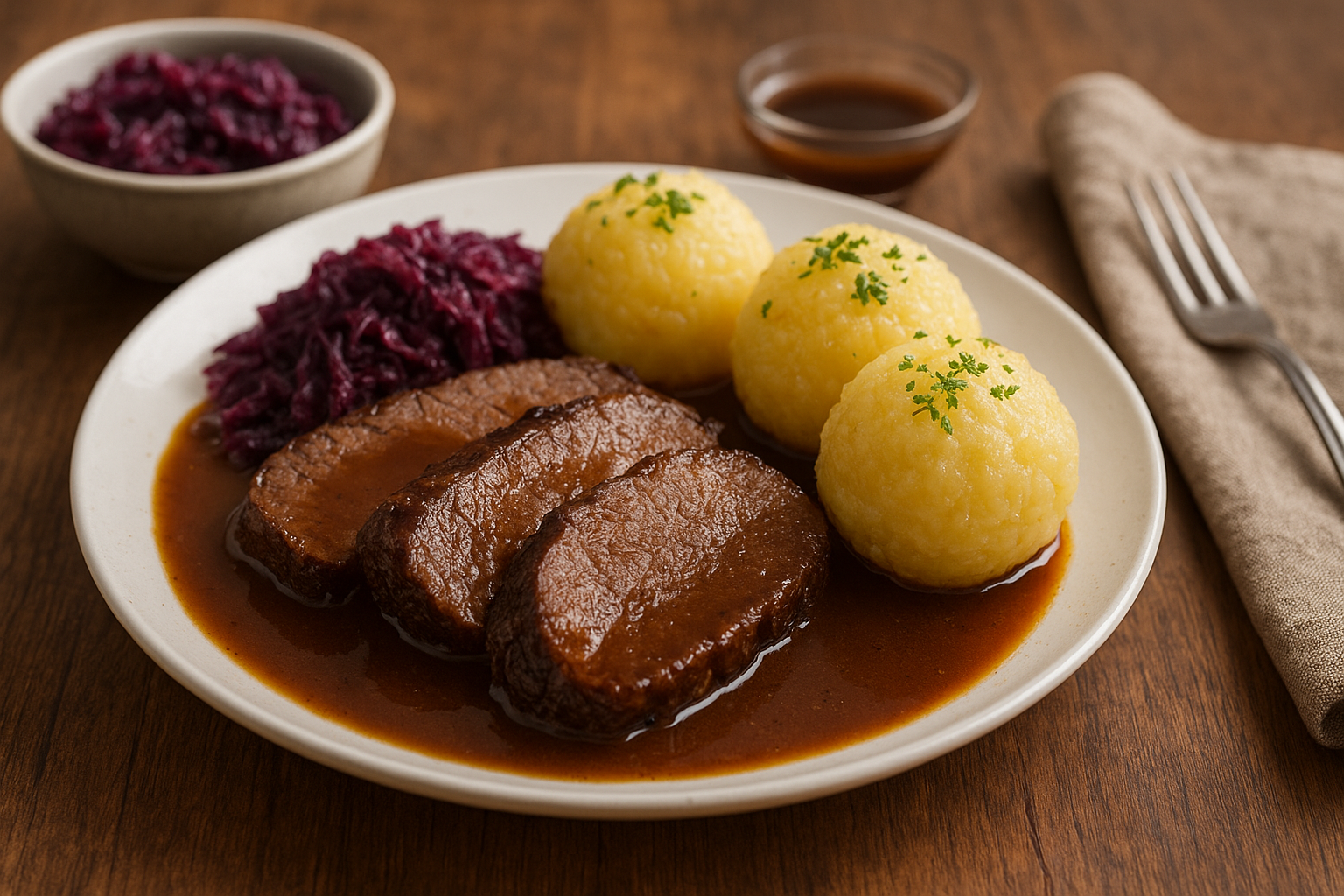Sauerbraten-German Pot Roast

Sauerbraten-German Pot Roast, often hailed as Germany’s national dish, is a hearty pot roast distinguished by its unique method of preparation. Marinating the meat for several days in a mixture of vinegar, wine, water, onions, and spices before slow-braising it to tenderness. The name itself means “sour roast,” a reference to the tang imparted by the vinegar-based marinade. Traditionally made with beef, variations can be found using pork, venison, lamb, or even horse in some regions. The long marination not only tenderizes tougher cuts of meat but also infuses them with a deep, complex flavor that balances sweet, sour, and savory elements.
Origins & History
The origins of Sauerbraten trace back to the Rhineland. Though many German regions, including Franconia, Swabia, Saxony, and Thuringia, have their own versions. They have subtle variations in ingredients and accompaniments. In the Rhineland style, the sauce is typically enriched with gingersnap cookies. They thicken it and lend a gentle sweetness to contrast the tart marinade. In Swabia, raisins might be added. While Franconian versions sometimes lean more heavily on red wine.
Historically, Sauerbraten is said to date back to the time of Charlemagne in the 9th century. Legend suggests he instructed his cooks to preserve meat in a vinegar marinade as a way to prevent spoilage. Another enduring tradition connects the dish to Saint Albertus Magnus, a medieval scholar and bishop of Cologne. He may have popularized the technique of marinating meat. By the 19th century, Sauerbraten had become a beloved Sunday and holiday meal throughout Germany. It symbolizes comfort, resourcefulness, and regional pride.
Typically, Sauerbraten is served with potato dumplings, red cabbage, or spätzle. Thus making it a complete and satisfying meal. Its longevity and adaptability reflect the German culinary tradition of maximizing flavor through patience and careful preparation. These qualities have made Sauerbraten a classic both at home and abroad.
Sauerbraten-German Pot Roast
Ingredients
Method
- Marinate the Beef: In a large pot or non-reactive bowl, combine wine, vinegar, broth, vegetables, garlic, and spices.Submerge the beef roast in the marinade, cover tightly, and refrigerate 3–5 days. Turn the meat daily to ensure even soaking.
- Build Flavor: Add strained vegetables to the pot. Cook until lightly browned (sprinkle with sugar if desired to caramelize).Sprinkle flour over vegetables, stirring until absorbed.
- Braise the Roast: Return beef to pot. Pour in reserved marinade liquid (about 3–4 cups). Bring to simmer.Cover and braise at low heat (stovetop or 325°F oven) for 2½–3 hours, until beef is fork-tender.
- Make the Sauce: Remove beef and keep warm. Strain the braising liquid into a saucepan.Whisk in crushed gingersnaps to thicken the gravy. Simmer until smooth and rich. Adjust seasoning with salt and pepper.
- Serve: Slice beef across the grain.Serve with sauce, potato dumplings (Kartoffelklöße) or spätzle, and braised red cabbage.
Notes
Serving Tips for Sauerbraten
Traditional Sides
- Potato Dumplings (Kartoffelklöße): The classic choice, perfect for soaking up the rich gravy.
- Spätzle: Soft egg noodles that pair beautifully with the tangy sauce.
- Braised Red Cabbage (Rotkohl): Adds color, sweetness, and acidity to balance the deep flavors.
- Mashed Potatoes or Boiled Potatoes: A simpler alternative if dumplings feel too heavy.
Garnishes
- Freshly chopped parsley sprinkled on dumplings or cabbage for brightness.
- A dollop of sour cream on the side to soften the marinade’s tang.
- Pickled vegetables (like cornichons or pickled beets) for a sharp contrast.
Wine Pairings
Because Sauerbraten has both tangy and sweet notes, you want wines that balance acidity with fruitiness: Red Wine Options:- Spätburgunder (German Pinot Noir): Light-bodied, fruity, and earthy; complements the marinade.
- Dry Riesling (Trocken): Crisp acidity cuts through the rich gravy while echoing the dish’s vinegar base.
- Gewürztraminer: Aromatic, slightly off-dry, and spicy—pairs well with red cabbage and clove in the marinade.
Beer Alternative
- Dunkel or Märzen (Oktoberfest beer): Malty, smooth, and perfectly German.
